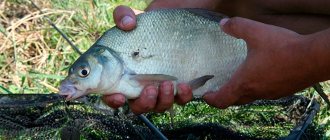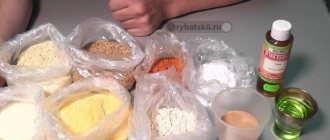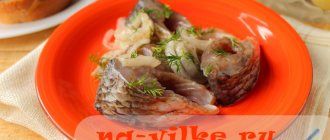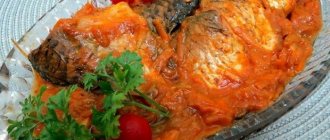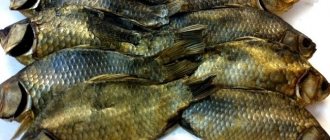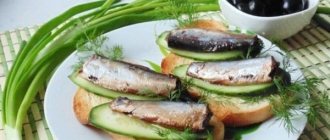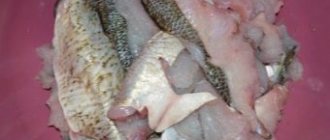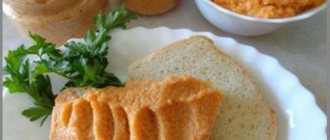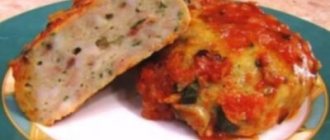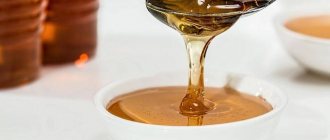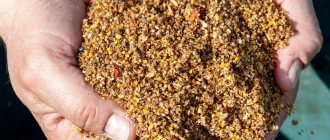How to choose boilies for crucian carp?
Boyle is a ball with a dense structure, which is a type of bait. If cooked for a long time, they will drown in water; if, on the contrary, you cook for a short time, they will float.
This variety appeared in the arsenals of fishermen relatively recently, but immediately became in high demand not only for its cost, but also for its efficiency of use.
There are boilies:
- Sinking, respectively, when used, they drown in water, the fish can pick it up at the bottom;
- Dusting - do not absorb liquid, which allows the bait to be stored for a long time;
- Floating, do not sink and are always on the surface;
- Neutral - located at the bottom, but do not bury themselves in the silt.
Good to know! The choice of such bait for crucian carp should correspond not only to the time of year, but also to the fishing location.
So, for example, for a flat bottom you can use a sinking boilie, and in muddy areas a neutral one will work well.
Coloring and flavoring
Each angler independently, based on his knowledge of a particular body of water and experience, determines what color to paint and what flavor to give to his homemade bait. flavor such dough balls using either improvised means or special purchased essences, which are effective and economical to use. We can recommend that you give preference to the aromas of honey, vegetables, fruits, berries, as well as various oily essences that perfectly attract fish.
You can paint boilies in bright shades, and for night fishing we can recommend choosing a bait to which a few drops of fluorescent dye are added, which allows you to make it visible to fish even in the dead of night. However, there is no universal recommendation in this case. Only fish choose one or another color of bait solely from their preferences, and their preferences may change depending on the time of year or the light level of the water.
Homemade boilies for crucian carp
Bait can only be purchased in a store, but you can also make it yourself. To do this, you need to decide on a recipe that will be appropriate for the fish and the fishing location.
The composition of the boilie depends on:
- Season - in winter there should be more protein in the bait;
- Moods - crucian carp is a capricious fish, so you may not bite, but your neighbor next to you will bite, although the bait will be the same;
- Reservoir - if crucian carp is grown artificially in the place. Accordingly, they feed every day, then it will no longer bite on regular bait.
Main components
Depending on the manufacturer, the components of the bait may be different, but there are those components without which it is impossible to achieve a positive result.
The main components include:
- Flour, can be different pea, wheat;
- Salt and sugar, preferably in small grains;
- Egg – will add viscosity to the consistency; if missing, it is recommended to replace it with gelatin;
- Flavoring in the form of dill, cinnamon;
- Flavor enhancers - fish oil, nuts, seeds.
Let's celebrate! In addition, glycerin and acid can be added to store-bought boilies; at home, you can get by with the basic composition.
Flavors and dyes
The flavoring does not affect the taste, but acts as an appetite stimulant, so it is believed to increase fishing efficiency. Among all the flavorings for crucian carp, garlic and ginger are suitable.
There is no need to choose strong odors, they can alert the fish or reject them altogether; in addition, it is not recommended to mix odors with each other.
Flavorings can also be purchased at the store, where they are sold in the form of powders and liquid formulations that should be added to the bait. Scents ranging from sweet to salty are available, allowing you to diversify your taste preferences.
Let's celebrate! Colorants should be red, yellow or green, usually done through food coloring.
Fishing tackle
For catching carp with a spring, any strong fishing rod with a length of 2.1 to 3.6 m, both plug-in and telescopic, is suitable. It can be expensive branded or cheap Chinese. The “stick” test must be more than 40 grams.
The reel is selected in size 3000-4000 with a baitrunner, the spool should hold 100 m of fishing line with a thickness of 0.25-0.3 mm.
Leashes are made from braid or monofilament with a breaking force of more than 3 kg, and the length of the leash ranges from 5 to 50 cm.
Hooks are used No. 4-8 depending on the bait used and the intended trophy.
The process of mounting a carp feeder to the main fishing line should be thorough and durable. If you use the donut spring option, you should attach the fishing line to one of the turns of this spring using a reliable and strong knot. For spring equipment like a combine, the fishing line itself from the equipment will be attached to the top of the feeder.
A prerequisite will be to tie the fishing line to the springs with strong and reliable knots; this fact is necessary so that when carrying out the processes of throwing the feeder, the feeder does not become untied from the fishing line. Since the feeder is quite heavy, these units will be subject to high loads.
For fishing with a spring, anglers use various types of gear, from donkeys with a rubber shock absorber to the most modern rods and reels.
Rod
It is better to use a special carp rod or feeder with a weight of up to 120 g. Such rods will ensure long-range and accurate casting of equipment, landing even very large carp, and most importantly, they are applicable for other types of bottom fishing.
Coil
For carp fishing, large spinning reels (4000–6000) with a low gear ratio are used. It is advisable that the reel be equipped with a line release system (baitrunner).
Braided fishing lines are used with sliding rigs, where the sensitivity of the gear is important. Thanks to the low elongation of the braids, even minimal effort is recorded when biting.
To catch carp with a spring, you first need to completely assemble and mount the tackle. For this you will need:
- Rod. It should be quite reliable and strong. Therefore, we recommend using a test load of 50 to 100 g. Length - from 2 to 4 m. This parameter is not important - you can proceed from which rod is easier for the fisherman to use.
- Coil. One of the most expensive components of the gear. You will need a spinning reel with a 3000-4000 spool. It would be nice if she also had a baitrunner.
- Fishing line. Everything here is the same as with any carp gear. The main fishing line is 0.23-0.32 mm monofilament or braided line with a breaking load of 3-15 kg. For leashes, you can also use either monofilament line or braided cord. True, already of a smaller diameter. The optimal length of leashes is from 5 cm to half a meter.
- Hooks. Sizes from 6 to 12 according to international numbering.
- Spring feeder. Weighing from 20 to 80 g. It is advisable to select a more accurate weight of the feeder taking into account fishing conditions, such as depth, current, bottom, etc.
Now let's move on to the equipment options. The spring can be used in 2 ways:
The first installation option is more reminiscent of a feeder. The feeder is attached to the fishing line through a special outlet tube, which ensures free movement. Usually within 30-50 cm. The leash (usually one) is attached using a carabiner or using a loop-to-loop method.
In the second option, the spring is firmly attached to the fishing line using a winding ring. Or the line is pulled through the winding tube of the feeder, then wrapped around it and tied in a knot. More leashes are often used than with sliding rigs. There are even up to 3-4 per feeder. The length of the leashes is from 5 to 15 cm. They are attached both to the main fishing line and to the coils of the spring.
As you can see, the installation of such equipment is not associated with any difficulties. In fact, there are two options for attaching a spring feeder - blind or sliding.
Choose any, but remember that when catching cautious fish, it is advisable to have equipment on which the spring moves freely between two stoppers. Thus, when biting, the carp does not feel resistance, and the bait seems like natural food to it.
If the bite is good, then you can resort to blind equipment, when the feeder is rigidly fixed to the fishing line. This helps the fish to hook itself when it swallows the bait.
DIY boilie recipes for crucian carp
If you cannot visit or purchase a boilie at a fishing store, you can make it yourself.
The manufacturing technology should be as follows:
- Select flour and knead the dough;
- Form balls of small diameter;
- Boil the balls in boiling water for 2-3 minutes;
- Remove and dry thoroughly;
- Use a needle to make a hole and tie a loop.
Note! The prepared nozzles can be stored in the freezer if you cannot use them immediately. Below are written recipes that are classified as simple and cheap.
Universal boilies
To prepare you need:
- 200 grams of corn flour;
- 100 grams of seeds;
- 2 eggs;
- 1 teaspoon sugar;
- 50 grams of vegetable oil.
Note! Grind the seeds and add other ingredients, knead well. The full list of actions was described above
Bread boilies
Crumb of black bread, to which you should add an egg yolk and a little vegetable oil; in addition, you can add flavoring if desired.
Manufacturing method:
- Remove the crumb from the bread and add other ingredients, mix thoroughly;
- Form small lumps and place in a bag that should be stored in the refrigerator.
Milk boilies
Milky bait, inexpensive but very effective.
Cooking method:
- Pour semolina and warm milk in a 1:1 ratio and leave for 1 hour to swell;
- Then add fish oil, salt, egg and vanillin to the resulting mixture;
- Stir and form lumps, cooking them for 2-3 minutes;
- Allow to cool and dry, ready to use.
Cake boilies
Ingredients:
- 200 grams of ground cake;
- 100 grams of processed cereal;
- 1 teaspoon sugar;
- 150 grams of milk.
Good to know! Mix and roll into balls. Fry on both sides until golden brown. Allow to cool and use.
Boilies for autumn-spring fishing
In cool water, boilies prepared as follows are most effective:
- 350 grams of wheat flour;
- 150 grams of semolina;
- 100 grams of crushed worms;
- 150 milliliters of milk;
- 100 grams of chocolate;
- a pinch of salt.
Note! This recipe can be made directly while fishing, having all the ingredients with you. Insects are a must in this recipe, since during this period the fish has a high need for protein.
Installation of equipment
To successfully catch carp with boilies, anglers came up with various options for installing equipment. However, in most cases, the best results are shown by classic “blind” equipment, which can be used in both still and running water. “Blind” installation is done as follows:
- at one end of a piece of leadcore about 70 cm long, a loop with a diameter of 1 cm is knitted;
- a pear-shaped sinker with a plastic rod running inside it is put on the leadcore;
- a medium-sized swivel is tied to the other end of the leadcore;
- a leash made of special leash material is attached to the swivel;
- a hook is attached to the leash;
- At the end of the leash, a loop is formed for attaching the boilie.
Leadcore can be either floating or sinking. Floating models are used when fishing with baits that have positive buoyancy and have increased softness and elasticity. It is preferable to use sinking options in combination with baits that have negative buoyancy and lie on the bottom during fishing. Sinking models are equipped with a heavy metal core, which helps press the equipment to the bottom and makes it invisible to the fish.
After forming a loop, it is better to put a heat-shrinkable tube on the resulting loop knot, which will increase the reliability of the knot and give the equipment a more aesthetic appearance
A novice carp angler should pay special attention to the fact that the sinker should not move freely along the leadcore. To securely fix the pear-shaped weight, the angler must hold it firmly with one hand, while using his free hand to pull on the end of the leadcore on which the loop is tied
This action will cause the swivel to fit into the plastic rod and securely lock the sinker into the bottom of the rig. Rigid fixation of the load is necessary, as this will ensure that the fish hooks itself during the bite.
On a note! Carp leader material is usually made of braided monofilament and has a dark color, which is less noticeable on the bottom soil.
The breaking load of the leash can vary from 10 to 40 kg. Monofilament fishing lines should not be used as a leader material, since they are more rigid, which prevents the fish from freely swallowing the boilie.
Particular attention should be paid to hooks that are used in combination with boilies. Unlike classic ones, carp hook models have a sting curved inward
This design of the sting facilitates easy penetration of the hook into the mouth of the fish while swallowing the bait. At the moment the carp spits out the boilie, the hook with a curved sting firmly bites into the lower lip of the fish.
Baits consisting of boilies of contrasting color often show good results.
Not all fishermen know how to properly attach a boilie to a carp rig. In order for every fish bite to bring prey, the fisherman needs to learn how to knit a fastening loop and attach a bait to it. To plant a boilie you will need:
- pass the free end through the eye of the hook and make several turns around the shank;
- pass the end through the eye again, while the length of the remaining tip should be at least 4 cm;
- form a loop with a diameter of 0.5–1 cm at the remaining end of the leash;
- drill a through hole in the boilie;
- using a special needle, pull the formed loop through the hole in the nozzle;
- insert a plastic stopper into the loop;
- Pull the attachment slightly until the loop is completely tightened.
When installed correctly, the distance from the bait to the hook should be about 0.5–1 cm. To attach boilies using this method, the angler will have to purchase a special needle, the design of which resembles a knitting needle. In addition, to drill a hole you will also need a specialized tool, which is like a small drill. As a limiter, you can use a short plastic rod 3–5 mm long, which can be purchased at a fishing store. If you don’t have a purchased limiter at hand, you can always replace it with a piece of a match or a small stick.
Advantages and disadvantages of catching crucian carp with boilies
The positive side of using boilies includes:
- Self-made baits can cope well with luring;
- Lures for crucian carp are large in size, which allows you to catch a large catch;
- Crucian carp is attracted to food in muddy places, which it picks up from the bottom; in this case, it is wiser to use a neutral boilie;
- Even if you haven’t had time to use the balls, they can be stored in the refrigerator without losing their properties;
- They hold up well in water and do not fall apart if made correctly.
Flaws:
- Specialized balls for crucian carp are difficult to find in the store;
- Making it yourself takes time.
Ingredients used
The basis of such self-made boilies will be a special dry base mixture , the recipes for which are given below. Also, to make bait you will need the following products and additives:
- Fresh eggs.
- Flavors.
- Food colorings.
- Protein supplements.
With experience comes an understanding of what kind of boilies should be made for a particular body of water. The fisherman should use trial and error to find out all the taste preferences of the fish in the lake or river, and then he will be able to choose exactly the bait that will be effective and allow him to get the coveted trophy.
What gear should I use to catch crucian carp using boilies?
You can catch crucian carp using a boilie on:
- The spring, the catch with its help is simple, convenient and without extra costs. The positive aspects include a good catch compared to other species. It is used in ponds and lakes with minimal or no current.
The spring and hook are installed between the fishing line so that the invention does not float away into the mud or silt. Complementary food is stuck onto the spring itself so that the spring is not noticeable. When using the bait, the fish gets hooked on the spring and hooks on its own.
- Feeder is a bottom fishing tackle that even a novice fisherman can assemble. Attention should be paid to the base, it should be dense and stable, basically these are 2 rods of the same size and one 3-4 times smaller, from the resulting materials you should build a slingshot, the sharp end of which will be in the water. To hear the fish bite, you can use bells that will give a signal in time.
- An elastic band is a type of bottom fishing rod that looks like a 50-meter piece of fishing line. The end of the fishing line should have several hooks and a weight, as well as a shock-absorbing part.
The advantage is:
- No breakage at the wrong moment;
- Easy to get catch;
- It’s clear when the fish start biting.
Important Tips
In order to catch crucian carp with boilies even more successfully, you need to know some rules.
Namely:
- The boilie in the form of bait and in the form of a nozzle must have the same appearance and have the same taste.
- When attaching balls to a hook, it is necessary that the sting sticks out on the other side.
- When making delicacies yourself, you must use red dye, because crucian carp react best to it.
- In the winter season, you definitely need to add something tasty and meaty to your bait. These could be worms, bloodworms or small pieces of fish.
- When buying boilies for carp, in the absence of tasty food for crucian carp, the balls are slightly flattened on all sides so that they become smaller. Otherwise, the fish will not be able to swallow them.
Reviews from fishermen about homemade boilies
I have known this bait for a long time. Boyle is easy, cheap and effective, this is the main advantage. Grade:
Petr Ivanovich, 48 years old
The secret of using pulp lumps was told to me by my father. If I go on a long fishing trip, I definitely take them with me, even if I don’t have to put them in a cold place, and they don’t go missing. Grade:
Evgeniy, 23 years old
I’ve never used such a thing, after reading the reviews I also wanted to try it. I’ll be sure to add a review to see how my fishing goes. Grade:
Andrey, 36 years old
For a long time, milk bait has always accompanied me when fishing for crucian carp, I don’t know what this is connected with, but my catch has become much larger and of better quality. Grade:
Vladislav Evgenievich, 54 years old
As an avid fan of fishing at night in winter, I can only note the mood. If you go in a good mood and company, as well as with a full supply of fishing arsenal, the catch is always pleasing. I always use boilies with a bread crumb composition with the addition of any processed cheese. Grade:
Vasily Anatolyevich, 61 years old
Let's celebrate! Even according to the results of reviews, the effectiveness of using boilies has not been proven, however, you should adhere to the rules of use at different times of the year by selecting aromas and compositions, perhaps this will give a positive result. In any case, using a boilie will not cause significant harm to the fisherman, or to the fish either.
Catchy semolina boilies
Cyprinids bite well on semolina and boilies made from it. It is believed that the best time for semolina fishing is spring and early autumn. Preparing such bait from semolina is not particularly difficult. We also note the versatility of such a bait, which perfectly bites bream, carp, large carp, crucian carp, catfish and roach. This semolina bait is also often called pellets and red mullet. DIY boilie recipes for crucian carp are simple, so each of us can make this bait.
Boilies, their use
Initially, boilies were conceived as a nozzle attached to a hook , but over time other methods of attaching bait appeared.
The most popular method has become hair rigging. The essence of the method is that the boilie does not need to be placed on the hook; it is attached to a short piece of thin fishing line in the immediate vicinity of the hook. When fishing, even a very careful fish, after feeling the bait for a long time, will not detect a catch and will swallow the hook along with the bait. Self-cutting occurs. Hair rigging is applicable to all of the listed types of rigging.
The most effective equipment is the design of which includes feeders , which can be filled with bait boilies or specially prepared groundbait. When buying boilies for catching crucian carp, you need to pay attention to several important factors: take several packages with different aromas and tastes. The smell and taste of bait (purchased by the fisherman himself or bait boilies) should be similar to the smell of the bait. When placing the boilie on the hook, make sure that the tip of the hook remains free.
